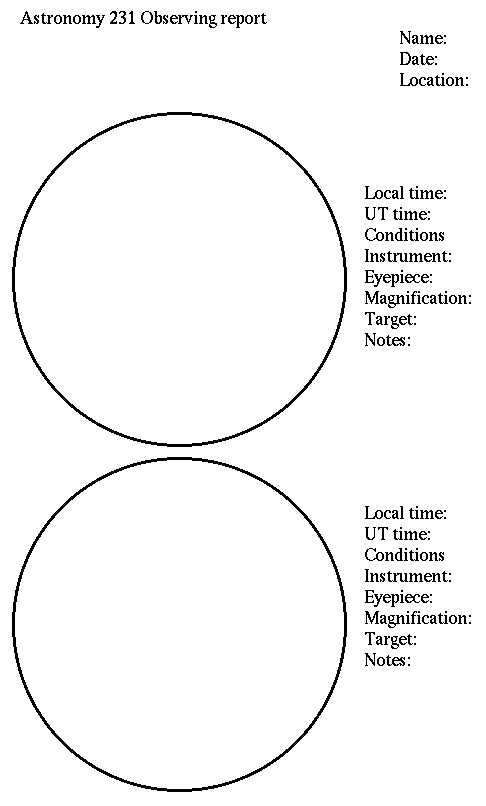
 Copyright © Michael Richmond.
This work is licensed under a Creative Commons License.
Copyright © Michael Richmond.
This work is licensed under a Creative Commons License.
You can find observing forms on-line, or ask the instructor.
Pick two different telescopes and use them to look at Jupiter. You should be able to see details of the planet's atmosphere, and its brightest moons.
Question 1: Draw two pictures of Jupiter and its moons, as seen with your instruments. Try to include any features you can see in Jupiter's atmosphere. Pay special attention to the positions of Jupiter's moons -- draw them just as they appear in the eyepiece. Indicate the relative brightness of each of the visible moons.
You will probably need to answer the following questions sometime after tonight's lab session.
Question 2: Use Sky Map Pro to identify each of the moons you drew. Make a table showing the distance of each moon from Jupiter in arcseconds, as given by Sky Map Pro, and the magnitude of each of the moons.
- How well do the positions of the moons in your pictures agree with the numbers from Sky Map Pro?
- How well do your estimates of the relative brightnesses of the moons agree with the magnitude values from Sky Map Pro?
Question 3: Estimate the field of view of each telescope, using Jupiter and its moons as a scale.
Question 4: Use Sky Map Pro to find the polar diameter of Jupiter on the night you observed it, in units of arcseconds (it should be somewhere between 30 and 50 arcseconds wide). In addition, look up the polar diameter of Jupiter, in units of kilometers. What is the ratio of kilometers per arcsecond?
Question 5: Based on your best drawing, estimate the north-to-south width in arcseconds of the most obvious bands in Jupiter's atmosphere. Use the width in arcseconds, and the ratio of kilometers to arcseconds, to calculate the width of the bands in kilometers.
Question 6: Find a book (not a Web site, a book) which has good pictures of the Jupiter. Use one of its pictures to measure the width of the atmospheric bands near the equator.Compare these values to the ones derived from your own visual observations. Are your values within 10 percent of the book's values?
- What is the width of the bands, in inches on the page?
- What is north-south diameter of Jupiter, in inches on the page?
- What is the width of the bands, in km?

This page maintained by Michael Richmond. Last modified Apr 12, 2002.
 Copyright © Michael Richmond.
This work is licensed under a Creative Commons License.
Copyright © Michael Richmond.
This work is licensed under a Creative Commons License.